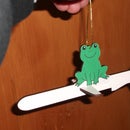Introduction: Rat Inna Bun
Following the success of Rat-Onna-Stick, it was time to crack on with C.M.O.T. Dibbler's other most famed street food.
This would have been entered in the Sandwich Competition, but sadly NZ went into lockdown just before my rat-making tools were printed and so I had to wait until now.
Still, it's never a bad time for a rat sandwich, so let's crack on.
Supplies
Seasonings:-
paprika, brown sugar, salt, ground black pepper, garlic powder, Worcestershire Sauce, soy sauce
or your favoured seasoning for hamburgers
Meat:-
I used cow. Other meats are available. If you use rat, then please post a photo^W^W^W get help.
One kilogram of minced beef (two pounds) gave me six burgers. Scale the 3-D print if you want larger or smaller burgers.
Step 1: Seasoning
This was a bit of a revelation to me. Apparently adding some seasoning to minced beef means it tastes better. After a lifetime of eating mince in Scotland, I had no idea that it could actually be a pleasant meal.
A few experiments led me to combine the mixes from SweetPhi and LayersOfHappiness.This tasted really good, without any of the seasonings being too obvious.
1 1/2 teaspoon of paprika
1 1/2 teaspoon of brown sugar
1/2 teaspoon of salt
1/2 teaspoon of ground black pepper
1/2 teaspoon of garlic powder
2 tablespoons of Worcestershire Sauce
2 tablespoons of soy sauce
Mix the dry ingredients together with a spoon until they are homogenous.
Knead the mixture into the minced (ground) beef. You can't really use a tool for this and still get it well mixed, so just get your hands all meaty.
Add the soy and Worcestershire to the meat and mix it well. A wooden spoon can do this job which makes it a little less messy.
Obviously, if you have a preferred (or purchased) seasoning mix, then you can save a bit of time.
Step 2: Printing the Mould (Mold)
Actually, this should probably be an earlier step unless you have a really fast 3-D printer.
Use a fairly fine-grain resolution to get a nice smooth surface which can be cleaned.
Once the job has been de-rafted give it a handwash with dishwashing liquid in hot water, having regard to the properties of whatever filament you used.
Attachments
Step 3: Shaping and Cooking
Weigh out a lump of the seasoned meat. I used about 160g (6oz).
Place the meat inside the mould (mold) and press it into all the corners with your fingers, making sure it reaches all the edges.
Get it as smooth and even as you can with your fingers, then place the press on top and force it down as hard as you like. The more solid you make the patty, the better it will hold together while cooking.
After having pressed very enthusiastically, I discovered that the patty sometimes liked being on the board and didn't want to move. Having a small square of baking parchment underneath the patty when you're pressing it will make it easier to more to the frying-pan or grill.
Then burn it until it looks done. If you don't know how to burn meat, then ask any man at any barbeque. They are the experts in burning meat.
Step 4: Decorating
The world is your oyster.
Technically, I suppose that the world is your rat, but that doesn't sound as good.
Obviously the first, and most important step, is to ensure that there is adequate beetroot involved. In most of the examples above, there were slices underneath the meat, in with the onion, tomato and other garnishes. As the great Goldstein said "Steering wheel on the right. Drive on the left. Beetroot on the hamburgers."
Ears:-
With small beets, a slice is just about the right size to emphasise the ears of the rodent.
For a change, a appropriately sized ring from a slice of onion can be used, then filled-in with tomato sauce.
Eyes:-
- As you can see from the fourth example, cutting eyes from beetroot didn't really work very well.
- In the third example above, the eyes were made by carefully dropping a single drip of tomato sauce (ketchup might work) from a pipette.
- The eyes in the second example were made by using a piece of 9mm brass to punch out a cylinder of beetroot from a slice.
- The first example above (and the final one made) shows beetroot ears and eyes made from the innermost core of a slice of onion with a tomato sauce pupil (very delicate!).
Tail and Whiskers:-
In all cases, the tail was made from the stalk of a stem of parsley, while a couple of parsley florets were carefully trimmed to give surprisingly effective whiskers. The tail was wedged under the patty which proved secure enough for serving, and the trefoil nature of the parsley floret stalk meant that it too was reasonably robust when just laid on the burger.
I'm sure that there are many other non-beetroot themed ways to provide the features, so please post a photograph in the comments if you've come up with something particularly lifelike or tasty :-)












